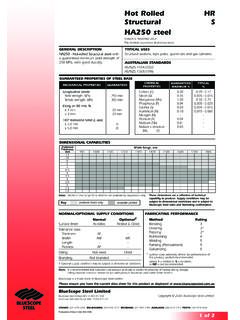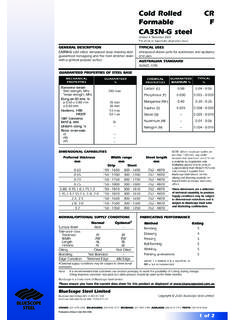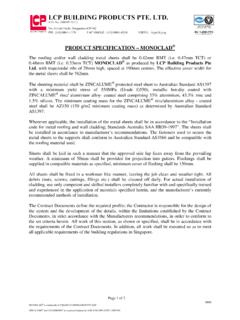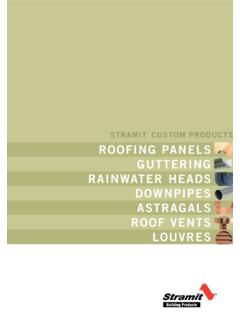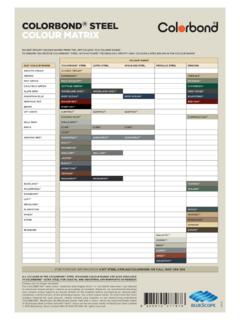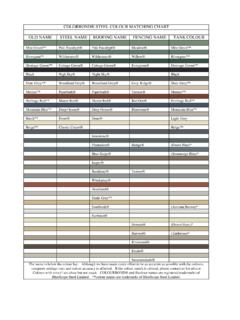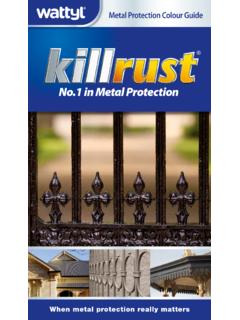Transcription of CORROSION - BlueScope
1 CORROSION . DISSIMILAR. METALS. TECHNICAL BULLETIN CTB-12. Rev 3, November 2003. This issue supersedes all previous issues If two different metals are placed in electrical Figure 1: Galvanic Series of Metals and Alloys contact and bridged by an electrolyte, a in Sea Water current flows through the solution from the anodic to the cathodic or more noble metal. NOBLE (CATHODIC). As a result, the cathodic metal tends to be Gold protected but the anodic materials may suffer Platinum great CORROSION . Titanium Figure 1, shows a Galvanic Table which lists Graphite metals from the least active (noble) to the most Silver active metals. Such tables are of significant Stainless Type 316. value in drawing the attention of designers to Stainless Type 310. the dangers of bi-metallic CORROSION . The PASSIVE Stainless Type 304. tables, however, must be interpreted not only Stainless Type 302. on a basis of the potential difference between Stainless Type 430. the metals in the table, but the area Stainless Type 410.
2 Relationship between cathodic and anodic metals and the ability of some materials to 80% Ni 15% Cr form stable passive oxides. The latter Inconel PASSIVE. phenomenon can control the overall CORROSION 60% Ni 15% Cr reaction leading to a significant decrease in the Nickel rate of material loss. Monel Copper-Nickel A guide to the compatibility of various metals Bronzes and alloys in contact is shown in Figure 2. Copper One exception to the necessity for the two Brasses metals or alloys to be in direct electrical 80% Ni 20% Cr contact for metallic CORROSION to occur, is Inconel when the noble metal corrodes slightly and ACTIVE. 60% Ni 15% Cr dissolves in water which subsequently flows Nickel over a less noble material. Tin The CORROSION product from the more noble Lead metal may then deposit on the less noble Stainless Type 316. metal forming a true bi-metallic contact. Stainless Type 310. An example of this reaction is when copper Stainless Type 304. ACTIVE. can dissolve very slightly in some natural Stainless Type 302.
3 Waters and re-deposit on zinc or Stainless Type 430. zinc/aluminium coated steel. Hence bi-metallic Stainless Type 410. CORROSION may be experienced when two Cast Iron dissimilar metals or alloys, not in direct Carbon Steel contact are nevertheless connected electrically. Cadmium Obviously bi-metallic CORROSION is more severe Aluminium under immersed conditions than when Zinc exposed to normal atmospheric environments. Magnesium Alloys In the case of atmospheric environments, Magnesium CORROSION will only occur when the bi-metallic couple is wet. ACTIVE (ANODIC). Figure 2: Compatibility of Direct Contact between Metals or Alloys Accessory/Fastener Material Cladding Stainless Zinc-Coated Zinc/ Copper Carbon Material Steel Steel and aluminium Aluminium Lead Monel (300 Series) Zinc coated steel & Brass Black**. Zinc-coated steel & zinc No Yes Yes* Yes* No Yes** No No Zinc/aluminium . coated steel No Yes* Yes Yes No No No No colorbond No Yes* Yes Yes No No No No colorbond METALLIC No Yes* Yes Yes No No No No colorbond ULTRA No Yes* Yes Yes No No No No colorbond STAINLESS Yes No No No No No No No Key: * Inert catchment situation may apply.
4 (See Technical Bulletin TB15). ** Not recommended for severe environments. ** As found in some washers, roof penetration flashings and black lead pencils etc. This is related to many factors such as the This effectively couples the insulated noble presence of moisture in crevices, speed of fastener material to the more anodic steel sheet evaporation and specific time of wetness. resulting in CORROSION of the colorbond . Generally, under atmospheric conditions steel sheeting about the fastener head. bi-metallic CORROSION is usually localised at the This mechanism is further enhanced should point of contact. Our experience has shown the washer used to seal the fastener contain that significant CORROSION of the less noble or carbon black. Carbon black is highly the more anodic component is dependent conductive and is capable of initiating and upon the time of wetness which can be further maintaining a significant CORROSION reaction accelerated by contamination of the surface even in the absence of a noble or cathodic with conductive salts.
5 Fastener. Washers free of carbon black are A typical example of this reaction can be seen readily available. to be associated with stainless steel self drilling One unusual example of such galvanic activity roof screws which have been incorrectly used is related to the CORROSION induced by the use to fix colorbond prepainted steel roof of common black marking pencils on bare sheeting. The consequent establishment of an galvanized and ZINCALUME zinc/aluminium area of CORROSION approximately 40 mm in alloy-coated steel products. Black lead . diameter on the roof sheeting about the screw pencils contain graphite/carbon rather than head is initiated by the deposition of detritus lead. This reacts with the metallic coating from the environment, which greatly extends resulting in indelible marking or fine CORROSION the time of wetness. The deposit contains salts of the sheet surface and, in aggressive from the surrounding environment and extends environments, severe knife like CORROSION of to a discontinuance in the organic coating on the metallic coating.
6 The sheeting adjacent to the fastener. The information and advice contained in this Bulletin is of a general nature only, and has not been prepared with your specific needs in mind. You should always obtain specialist advice to ensure that the materials, approach and techniques referred to in this Bulletin meet your specific requirements. BlueScope Steel Limited makes no warranty as to the accuracy, completeness or reliability of any estimates, opinions or other information contained in this Bulletin, and to the maximum extent permitted by law, BlueScope Steel Limited disclaims all liability and responsibility for any loss or damage, direct or indirect, which may be suffered by any person acting in reliance on anything contained in or omitted from this document. ZINCALUME and colorbond are registered trade marks of BlueScope Steel Limited. BlueScope is a trade mark of BlueScope Steel Limited. Please ensure you have the current Technical Bulletin as displayed at BlueScope Steel Copyright 2003 BlueScope Steel Limited BlueScope Steel Limited ABN 16 000 011 058.
7 BlueScope Steel (AIS) Pty Ltd ABN 19 000 019 625. AUSTRALIA. SYDNEY Telephone: (02) 9795 6700. OVERSEAS. BlueScope Steel (Malaysia) Sdn Bhd Telephone: (603) 3250 8333. MELBOURNE Telephone: (03) 9586 2222 BlueScope Steel (Thailand) Limited Telephone: (66 38) 685 710. BRISBANE Telephone: (07) 3845 9300. PT BlueScope Steel Indonesia Telephone: (62 21) 570 7564. ADELAIDE Telephone: (08) 8243 7333. PERTH Telephone: (08) 9330 0666 BlueScope Steel Southern Africa (Pty) Limited Telephone: (27 21) 555 4265. Produced by Artimprint (02) 9984 8586.
